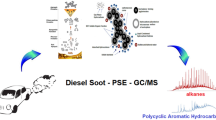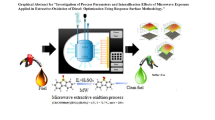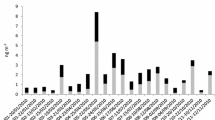Abstract
Pressurised microwave-assisted extraction was used to extract a complex mixture containing polycyclic aromatic hydrocarbons (PAHs), nitrated PAHs and heavy n-alkanes from a particularly refractory carbonaceous material resulting from the combustion in a diesel engine. A second-order central composite design was used to determine the optimal conditions of extraction in terms of time, temperature, volume and nature of extracting solvent from spiked diesel soots. To begin, methylene chloride, tetrahydrofuran and chloroform were tested for extracting the spiked diesel particulates; however, the nature of these solvents was not really an influential factor. Volume was the most influential factor and was kept at a medium level to enhance the extraction of heavy PAHs without introducing an important dilution factor. Temperature and time were not influential as main factors but interacted with the other factors. Finally, high temperature and duration associated with a medium volume of methylene chloride were better for the extractions. After this optimisation, five-ring and six-ring PAHs were nevertheless not satisfactorily desorbed. Other solvents were therefore tested. Only aromatic ones, and particularly heterocyclic aromatic solvents, managed to desorb the heaviest PAHs. Pyridine, with its both aromatic and its basic character, was the most successful solvent. Desorption was even complete with an addition of 17% of diethylamine into pyridine. So, using MAE, we succeeded in extracting quantitatively, from the spiked refractory diesel soot surface, two-ring to six-ring PAHs, heavy n-alkanes and short nitrated PAHs. However, heavy nitrated PAHs were better extracted with a small addition of acetic acid (1%) into pyridine instead of a basic cosolvent.




Similar content being viewed by others
References
Neeft JPA, Makkee M, Moulijn JA (1996) Fuel Process Technol 47:1–69
Rhead MM, Hardy SA (2003) Fuel 82:385–393
Veigl E, Posh W, Lindner W, Tritthart P (1994) Chromatographia 38:199–206
Barzegar M, Danehfar A, Asharf-Khorassani M (1997) Anal Chim Acta 349:245–252
Collins JF, Brown JP, Alexeef GV, Salmon AG (1998) Regul Toxicol Pharm 28:45–54
Gratz LD, Bagley ST, Leddy DG, Johnson JH, Chiu C, Stommel P (2000) J Hazard Mater 74:37–46
Shu YY, Lao RC, Chiu CH, Turle R (2000) Chemosphere 41:1709–1716
Chesler SN, Emery AP, Duewer DL (1997) J Chromatogr A 790:125–130
Miege C, Dugay J, Hennion MC (2003) J Chromatogr A 995:87–97
Zougagh M, Redigolo H, Rios A, Valcarcel M (2004) Anal Chim Acta 525:265–271
Bonfanti L, Careri M, Mangia A, Manini P, Maspero M (1996) J Chromatogr A 728:359–369
Saim N, Dean JR, Pauzi-Abdullah M, Zakaria Z (1997) J Chromatogr A 791:361–366
Flotron V, Houessou J, Bosio A, Delteil C, Bermond A, Camel V (2003) J Chromatogr A 999:175–184
Dean JR, Xiong G (2000) Trends Anal Chem 19:553–564
Turrio-Baldassari L, Battistelli CL, Iamiceli AL (2003) Anal Bioanal Chem 375:589–595
Bucheli TD, Gustafsson O (2003) Chemosphere 53:515–522
Benner BA (1998) Anal Chem 70:4594–4601
Fernandes MB, Brooks P (2003) Chemosphere 53:447–458
Murayama M, Dasgupta PK (1996) Anal Chem 68:1226–1232
Jiao KS, Lafleur AL (1997) J Chromatogr A 791:203–211
Schantz MM, Nichols JJ, Wise SA (1997) Anal Chem 69:4210–4219
Yang Y, Garaibeh A, Hawthorne SB, Miller DJ (1995) Anal Chem 67:641–646
Shu YY, Lai TL, Lin HS, Yang TC, Chang CP (2003) Chemosphere 52:1667–1676
Bruno P, Caselli H, de Gennaro G, Tutino M (2007) Talanta 72:1357–1361
Pino V, Ayala JH, Afonso AM, Gonzalez V (2003) Anal Chim Acta 477:81–91
Tomaniova M, Hajslova J, Pavelka J Jr, Kocourek V, Holadova K, Klimova I (1998) J Chromatogr A 827:21–29
Shu YY, Tey SY, Wu DKS (2003) Anal Chim Acta 495:99–108
Chee KK, Wong MK, Lee HK (1996) Anal Chim Acta 330:217–227
Villar P, Callejon M, Alonso E, Jimenez JC, Guiraum A (2004) Anal Chim Acta 524:295–304
Budzinski H, Letellier M, Garrigues P, Lemenach K (1999) J Chromatogr A 837:187–200
Noordkamp ER, Grotenhuis JTC, Rulkens WH (1997) Chemosphere 35:1907–1917
Snyder LR, Kirkland JJ (1999) Introduction to modern liquid chromatography, 2nd edn. Wiley, New York
Goupy J (1988) La méthode des plans d’expérience. Dunod, Paris
Sado G, Sado MC (1991) Les plans d’expérience. AFNOR Technique, Paris
Acknowledgement
The authors express their gratitude to the Région Haute Normandie for financial support within the context of TOPAASE research programme.
Author information
Authors and Affiliations
Corresponding author
Rights and permissions
About this article
Cite this article
Portet-Koltalo, F., Oukebdane, K., Dionnet, F. et al. Optimisation of the extraction of polycyclic aromatic hydrocarbons and their nitrated derivatives from diesel particulate matter using microwave-assisted extraction. Anal Bioanal Chem 390, 389–398 (2008). https://doi.org/10.1007/s00216-007-1684-2
Received:
Revised:
Accepted:
Published:
Issue Date:
DOI: https://doi.org/10.1007/s00216-007-1684-2




